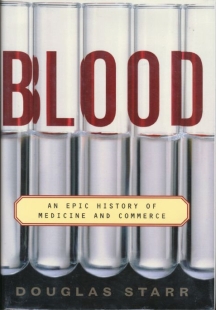Blood: An Epic History of Medicine and Commerce
Douglas Starr
Alfred A. Knopf
US Trade hardcover
ISBN 0-679-41875-X
Publication Date: 12-1998
441 pages; $27.50; ;
Date Reviewed: 01-21-1999
Reviewed by Rick Kleffel © 2002

REFERENCES
COLUMNS
|
|
|
Blood: An Epic History of Medicine and CommerceDouglas StarrAlfred A. KnopfUS Trade hardcoverISBN 0-679-41875-XPublication Date: 12-1998441 pages; $27.50; ;Date Reviewed: 01-21-1999Reviewed by Rick Kleffel © 2002 |
|
|
REFERENCES |
COLUMNS |
Blood is fodder for more than just an endless series of tawdry vampire novels. In 'Blood: An Epic History of Medicine and Commerce', Douglas Starr offers up no less than the title indicates. 'Blood' is a story of epic proportions with heroes, villains, horror, gore, and the evils of capitalism gone seriously crazy. Don't be daunted by the length -- the last 90 pages contain notes to the previous 350, documentation for the sometimes-unbelievable stories that proceed it. 'Blood' is never less than gripping, filled with vivid scenes and characters that linger on after the last drop of the story is gone.
Starr starts out with the earliest history of blood, when it more of a magical potion than a part of the body. In the winter of 1667, the first recorded transfusion was performed, when the blood of a calf was dripped into a madman in hopes that it '"by its mildness and freshness might possibly allay the heat and ebullition of [the patient's] blood."' As he progresses from the primitive and terrifying science of humours and vapours to the first stages of what becomes modern medicine, Starr recounts horror after horror in vivid detail.
He then jump cuts to the first days of transfusion, itself quite a horror story. The first transfusions were between two living patients, with the donor standing little better chance of surviving the procedure than the recipient. They were also performed under life-or-death conditions, the only acceptable conditions for experimental medicine. The devices used for transfusion look like something out of a David Cronenburg movie, and are illustrated in one of two sections of photos. As the technology for transfusion grew more available, doctors set up huge networks of live donors. These were people who would be on call if blood were needed. In the March 1930, Serge Yudin, a Russian doctor, unable to find 'blood on the hoof' as it was called, performed a daring and horrific experiment. A suicide was brought to him but no live donors were available. Because the man had tried to kill himself, Yudin rationalized that the man's heirs would have nothing to complain about if Yudin performed an experiment that failed. Yudin transfused blood from a fresh corpse into the suicide -- who lived. It was the first time "stored" blood had been used for a transfusion, and ushered in the modern age of blood as a product.
From the beginning blood products were problematic, and Starr's exploration of the 'Blood Wars' is fascinating and horrific. For a hero, we get Doctor Edwin Cohn, the driven genius who discovered fractionation of blood plasma and founded the modern American blood industry. For a troubled villain, we get Doctor Naito who founded the Japanese blood industry and the Green Cross after helping perform hideous experiments on prisoners during World War II. The technology and industries they started lead to the 'vampire blood bankers' of the early seventies, mercenaries who preyed on the poor in third world countries and polluted the blood supply in the process.
'Blood' concludes with the outbreak of AIDS, and the tragic record of negligent blood bankers who helped spread the epidemic through contaminated blood. He spares no one in his examination of this triumph of capitalism over common sense. Thousands of lots of contaminated blood were given to hemophiliacs who had little legal recourse. Starr shows how the attitudes developed by the blood bankers as early as WWII contributed to this travesty. 'Blood' tells the tale about the part of our body we give away, and exposes hundreds of little horror stories in the process. Whether you are a horror reader or writer, you will find much to enjoy in 'Blood'.